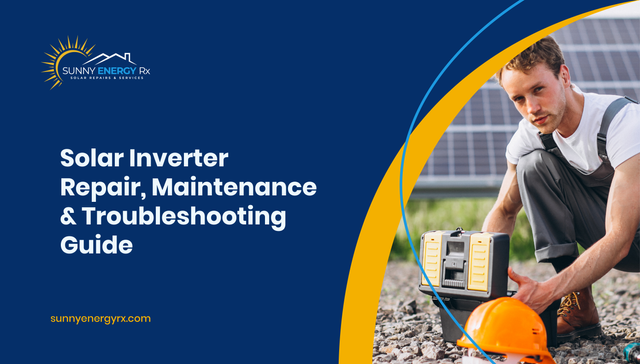Solar Inverter Acting Up? Your Arizona Guide to Fast Fixes and Lasting Performance
This blog was originally published on Sunny Energy RX.
When the Inverter Starts Talking
Your inverter is the system’s interpreter, and it rarely goes silent before a problem. Pay attention to status lights and error codes (green = normal; amber/red or fault codes = investigate). Snap photos of any codes your model’s manual explains what each one means and those screenshots speed up diagnosis for a technician. Sunny Energy RX
Sounds and Smells You Shouldn’t Ignore
A gentle hum (and an occasional fan spin-up) is normal. But persistent buzzing, a loud hum, or rapid clicking signals internal stress, often a failing transformer, capacitor, or fan. If you ever catch a hot, plastic smell, shut the system down using the proper sequence and call a pro immediately; that odor points to overheated components.
Why Inverters Fail Faster in Arizona
Even good hardware from brands like SolarEdge, Enphase, or SMA can struggle when extreme heat, dust, and tight spaces trap heat around the unit. Over time, high temperatures degrade electronics, and poor placement (direct sun, hot garages, no airflow) accelerates failure. Grid-side issues such as ground or isolation faults and voltage spikes can also force a protective shutdown, while firmware glitches or aging relays/MPPT circuits sometimes need repair or replacement.
Five Safe Steps Before You Call
- Photograph the front panel: lights, codes, and the surrounding area.
- Reboot by the book (check your manual for the shutdown/startup order).
- Confirm ventilation: clear boxes from around the inverter so it can breathe.
- Look for damage you can see from the ground: cracks, discoloration, rust, or water staining near vents or conduit.
- Stop if you smell burning, hear arcing/buzzing, or see scorch marks. Power down and book service.
Repair vs. Replace: How to Choose
Technicians will pull logs, check communications, and test strings/module-level devices to pinpoint the fault. Targeted fixes (fan, relay, firmware, wiring) are common; however, if diagnostics suggest a major internal component is failing or the unit is older and heat-stressed replacement can be the more reliable, warranty-friendly path. Loud humming tied to a transformer or big capacitor is a classic clue that a larger repair (or swap) is coming.
Make Maintenance Work for You (Not the Other Way Around)
You don’t need a complex routine to add years of life. Ensure the inverter has shade and airflow, keep the area dust-free, and avoid mounting locations that trap heat. Pair that with periodic professional checks (especially after storms or the hottest months) and you’ll prevent most surprise shutdowns.
What a Good Service Visit Includes
A quality Arizona service call is methodical: fault-code review, log pulls, communication checks, and on-site inspection for thermal or environmental stress (loose or corroded connections, heat discoloration, water ingress). You should leave with clear findings, a repair-vs-replace plan, and an itemized quote plus photos for your records.
Ready for Steady Green Lights Again?
If your inverter is throwing codes, humming louder than usual, or giving off any odd smell, act now. Quick attention prevents bigger failures in Arizona’s heat. Schedule inverter diagnostics and repair with Sunny Energy RX for brand-savvy troubleshooting, a clear fix plan, and simple preventive steps tailored to our desert climate so your system gets back to turning sunshine into savings without the drama and save your hard earned money. Checkout the official site for more insights on the topic.
